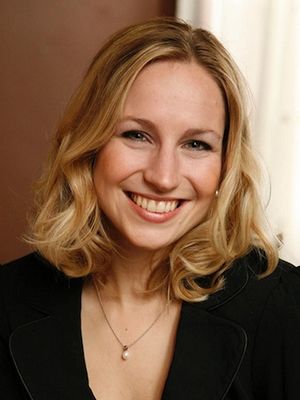Jocelyn Hagen
Jocelyn Hagen | |
|---|---|
 | |
| Born | April 19, 1980 Minneapolis, America |
| Citizenship | American |
| Education | Magna Cum Laude Bachelor of Music in Vocal Music Education Master of Arts |
| Alma mater |
|
| Occupation | Composer |
| Parent(s) |
|
| Awards | The American Prize Sage Award for "Best Overall Design" in 2015 |
| Website | jocelynhagen |
Jocelyn Hagen (born April 19, 1980) is an American composer. She composes primarily for voice: solo, chamber and choral, but also has composed for chamber, wind, and orchestral ensembles.[1] She has explored large-scale multimedia works, electro-acoustic music, dance, and opera. She is the co-founder and co-owner of Graphite Publishing, an online vocal music publisher of digital scores focused on promoting vocal music by living composers.[2]
Early life and education
Hagen was born in Minneapolis, Minnesota, but was raised in Valley City, North Dakota. She began piano lessons with her mother, Sara, who then joined the music faculty at Valley City State University.[3] Hagen learned piano quickly, and by the time she was in the second grade, she was able to accompany choir performances at Washington Elementary. She began experimenting with composition during her piano studies. She also learned the trumpet and horn and performed with school bands, as well as participating in musical theater and singing with choirs. When Hagen was a senior at Valley City High School, her choir director, Cindy Peterson, nurtured her compositional talent. Hagen composed a piece for the women’s choir, Evening Star, with text by Edgar Allen Poe.[1]
After graduating from Valley City High School, Hagen began studies at St. Olaf College in Northfield, Minnesota. During her freshman year, she sang with Manitou Singers, the first-year women’s chorus at St. Olaf. During the first semester of her sophomore year, Hagen transferred to Arizona State University. She soon returned to St. Olaf College and sang with the St. Olaf Chapel Choir, conducted by Robert Scholz. She studied composition with Timothy Mahr and Peter Hamlin. Hagen graduated Magna Cum Laude from St. Olaf College in 2003 with a Bachelor of Music in Theory and Composition, as well as a Bachelor of Music in Vocal Music Education.[4]
Hagen then earned a Master of Arts in Composition from the University of Minnesota, where she studied with Doug Geers and Judith Lang Zaimont, and graduated Summa Cum Laude in 2006.[1]
Career
After participating in a consortium commission for one of Hagen’s pieces, St. Catherine University offered Hagen a position as adjunct professor. Hagen taught orchestration in this role in 2007 and 2009.
Hagen has served as composer-in-residence for The Singers from 2004-2014.[5] From 2004-2005, Hagen was the composer-in-residence for the American Composer's Forum "Composer-in-the-schools" program at St. Paul Central High School in St. Paul, Minnesota. She was composer-in-residence at Valley City State University from 2006-2007, at Shorter College in Rome, Georgia from 2008-2009, at St. Catherine University from 2010-2011. She is currently composer-in-residence at North Dakota State University.[6]
Hagen has been awarded McKnight Artist Fellowships in 2010 and a grant from the Minnesota State Arts Board to complete a piece for the Metropolitan Symphony Orchestra in Minneapolis.[1] She received the Live Music for Dance grant from the American Composer's Forum in 2011 and 2014 to create new works with choreographer Penelope Freeh. She received the Sorel Foundation's recording grant in 2011 to record amass. Hagen has also received multiple other grants from the American Composer's Forum. She received The American Prize, third place, in Composition, Choral Division in 2015 for "Sanctus," from amass. She also received The American Prize, first place, for Opera/Musical Theatre in 2017, and the Sage Award for "Best Overall Design" in 2015 for Test Pilot.
Hagen was commissioned by the Minnesota Chorale and the Metropolitan Symphony Orchestra to compose The Notebooks of Leonardo da Vinci, a seven-movement multimedia experience. Since its premiere in March of 2019,[7] the piece has been performed in Michigan, Connecticut, California, Alabama and Montana.[8] The Carnegie Hall premiere is scheduled for April 19, 2020,[9] and will include orchestra and projection – a culmination of Hagen's vision for the piece.[10]
Hagen's music is independently published through JH Music, as well as through Graphite Publishing, G. Schirmer, Boosey and Hawkes, Santa Barbara Music Publishing[11], and Fred Bock Music Publishing.
In the media
External links
References
- ↑ 1.0 1.1 1.2 1.3 Culloton, Michael Patrick (2013). "Jocelyn Hagen and Timothy Takach: An Introduction to their Choral Music and a Study of their Positions within a Lineage of Minnesota-Based Composers".
- ↑ "About Graphite Publishing". Graphite Publishing. Retrieved 2020-03-05.
- ↑ "Valley City State University Staff Member". Valley City State University. Retrieved 27 February 2020.
{{cite web}}: CS1 maint: url-status (link) - ↑ Alumni, St Olaf. "Jocelyn Hagen '03 – St. Olaf Alumni". Retrieved 2020-03-02.
- ↑ "Composers". The Singers MCA. Retrieved 2020-03-02.
- ↑ "Jocelyn Hagen | Challey School of Music". www.ndsu.edu. Retrieved 2020-03-02.
- ↑ "The Notebooks of Leonardo da Vinci | Metropolitan Symphony Orchestra". Retrieved 2020-03-05.
- ↑ "Leonardo da Vinci comes to life in new work by Minneapolis composer Jocelyn Hagen". www.classicalmpr.org. Retrieved 2020-03-05.
- ↑ "The National Concert Chorus The National Concert Orchestra | Apr 19, 2020 at 8:30 PM". www.carnegiehall.org. Retrieved 2020-03-05.
- ↑ "The Notebooks of Leonardo da Vinci at Carnegie Hall Performance Opportunity! | Jocelyn Hagen". Retrieved 2020-03-05.
- ↑ "Jocelyn Hagen: Bio & Choral Music | Santa Barbara Music Publishing, Inc". sbmp.com. Retrieved 2020-03-02.
This article "Jocelyn Hagen" is from Wikipedia. The list of its authors can be seen in its historical. Articles taken from Draft Namespace on Wikipedia could be accessed on Wikipedia's Draft Namespace.